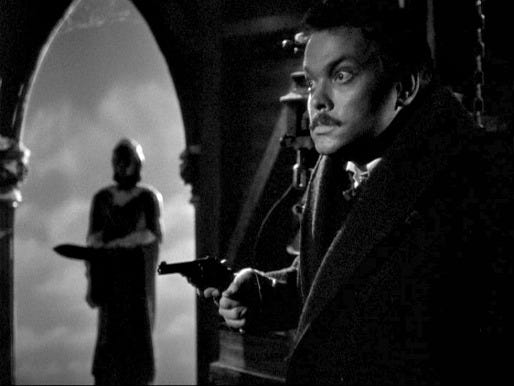The Stranger (1946)

I had never heard of "The Stranger," but it was actually Orson Welles' most commercially successful directorial effort — the only such effort, really. Coming out in 1946, it played on a lot of anti-Nazi hysteria about fascists hiding out among us after World War II. Welles is the supposed mastermind of the Holocaust, Franz Kindler, while Edward G. Robinson is the dogged G-man on his trail.
It seems Kindler has passed himself off as doddering professor Charles Rankin, who works at a boy's school in the Rockwellian town of Harper, Conn. He's even set to marry lovely girl next door Mary Longstreet (Loretta Young), whose father is a Supreme Court justice (Philip Merivale), don'cha know.
It's the perfect disguise...well, actually no. The best place to hide would not be in the heart of your greatest Allied enemy's country, where hordes of investigators are searching for runaway Nazis. All those stories about Hitler secretly living in Argentina were batty, but at least the Fuhrer hypothetically chose the right sort of location.
Switch it around and ask if it makes sense: If the Axis had won the war, do you think General Eisenhower would've hidden out in Hamburg, Germany?
The story is filled with a lot of holes and illogic, but it decently boils the plot. It also features some wonderfully inky photography by Russell Metty. Welles would later be associated with the film noir genre, most notably "Touch of Evil," but it was interesting to see him doing some early dabbling in that visual style.
There are a couple of scenes where Robinson acts in virtual darkness, with just one eye or a slice of his jaw clearly visible in the light. Welles also uses a lot of extreme close-ups, especially on himself, which has the intended disconcerting effect. (It also shows that Welles, at age 31, still struggled with acne.)
Oddly, the cinematography did not receive an Oscar nomination, but the film's one nod from the Academy was in the category where it most definitely did not deserve to be lauded: the screenplay. It's a jumble of mismatched characters and plot devices, with people doing things not because it makes sense but because the story needs to get from point A to B.
The script has a somewhat mysterious provenance, too. Victor Trivas received the Oscar nomination for Best Original Story, but Anthony Veiller is actually credited with penning the screenplay. Decla Dunning also helped adapt Trivas' story, and reportedly John Huston and Welles himself tinkered around with it, too.
Wilson, the Nazi hunter played by Robinson, has an especially tough job in catching Kindler. Despite being the wunderkind of the Third Reich, he was very secretive and no photos of him are available. He decides to free Konrad Meinike (Konstantin Shayne), a collaborator of Kindler's, from prison in the hopes he'll lead them straight to the main quarry.
This is exactly what happens, but Kindler kills Meinike before Wilson can make the connection, having been bonked over the head with a sandbag in the gym. Kindler leaves Meinike's body just a few steps into the forest surrounding the town, throwing a few shovelfuls of dirt and leaves over it.
For a supposed genius who conceived and executed the mass extermination of Jews, Kindler has a pretty weak M.O. for disposing of one dead man.
Wilson makes the connection that Rankin is Kindler because of a comment during dinner. Kindler advocates an extreme form of retribution against the defeated Germans — basically, wipe them all out, including women and children. He also disputes that Karl Marx was a German, because he was a Jew. He also has a keen interest in fixing the town's elaborate clock tower, and Kindler was known to be a nut for the stuff.
The creepiest, and most effective, part of the film is Kindler/Rankin's relationship with his wife. Mary at first defends her husband, refusing to believe the man she fell in love with could be a mass murderer. But as he comes to see her as the weak link in his alibi, Kindler soon turns his evil eye upon her.
All this leads up to an inevitable confrontation up in the clock tower where Kindler is hiding out after his cover his blown. Because, yeah, that's the last place anyone would think to look for him! But a Nazi who's stupid enough to hide out in America is probably also dumb enough to hole up in a place that everyone in town knows he frequents and lacks any sort of escape route.
The final showdown is kind of interesting, even if the build-up to it is daffy. Notably, it's Mary who fires the fatal shots that lead to Kindler's death — the betrayed woman exacting her revenge. The depiction is also rather violent, with Kindler getting impaled by the sword of the mechanical angel in front of the clock, which continually trades places with a winged devil. Subtle enough for you?
With its heavy-handed symbolism and dippy character construction, "The Stranger" is hardly one of best films in the Welles oeuvre, even if it is one of the better-looking.
3.5 Yaps



